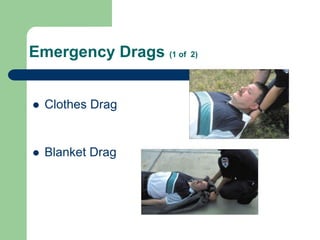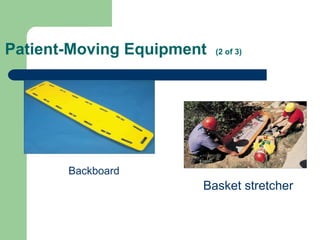LIFTING AND MOVING.ppt
- 1. Lifting and Moving Patients
- 2. is a rapid movement of patient from unsafe place to a place of safety.
- 3. Indications for Emergency Rescue Danger of fire or explosion
- 4. Danger of toxic gases or asphyxia due to lack of oxygen.
- 8. Danger of Collapsing Walls
- 9. is moving a patient from one place to another after giving first aid.
- 10. 1. Nature and severity of the injury. 2. Size of the victim. 3. Physical capabilities of the first aider. 4. Number of personnel and equipment available. 5. Nature of evacuation route. 6. Distance to be covered. 7. Sex of the victim. (Last consideration) Selection will depend upon the following:
- 11. Pointers to be observed during transfer. 1. Victim’s airway must be maintained open. 2. Hemorrhage is controlled. 3. Victim is safely maintained in the correct position. 4. Regular check of the victim ’s condition is made. 5. Supporting bandages and dressing remain effectively applied.
- 12. 6. The method of transfer is safe, comfortable and as speedy as circumstances permit. 7. The patient’s body is moved as one unit. 8. The taller first aiders stay at the head side of the victim. 9. First Aiders/bearers must observed ergonomics in lifting and moving of patient. Pointers to be observed during transfer.
- 13. Methods of Transfer One-man assist/carries/drags Assist to Walk Carry in Arms (Cradle) Pack strap Carry Piggy Back Cary Fireman’s Carry Fireman’s Drag Blanket Drag Cloth Drag Feet Drag Armpit/Shoulder Drag Inclined Drag
- 14. Methods of Transfer Two-man assist / carries Assist to Walk Four Hand Seat Hand as a Litter Chair as a Litter Carry by Extremities Fireman’s Carry (Assistance)
- 15. Methods of Transfer Three-man carries Bearers alongside (for narrow alleys) Hammock carry
- 16. Four/Six/Eight-man carry Blanket Carry Improvised stretcher using two poles with: Blanket , Empty sacks, Shirts or coats, Triangular bandages Commercial stretchers Ambulance or Rescue Van Other vehicles
- 17. Define body mechanics. Discuss guidelines and precautions when lifting patients. Describe safe lifting of cots and stretchers. Discuss guidelines and precautions when carrying patients and/or equipment. Objectives (1 of 3)
- 18. Discuss one-handed carry techniques. Discuss correct and safe carrying procedures on stairs. State guidelines for reaching and their applications. Discuss general considerations for moving patients. Objectives (2 of 3)
- 19. Describe correct reaching for log roll. State guidelines for pushing and pulling. State situations requiring emergency moves. Identify patient-carrying devices. Objectives (3 of 3)
- 20. Body Mechanics Shoulder girdle should be aligned over the pelvis. Lifting should be done with legs. Weight should be kept close to the body. Grasp should be made with palms up.
- 21. Proper Lifting
- 22. Performing the Power Lift (1 of 3) Tighten your back in its normal upright position. Spread your legs apart about 15". Grasp with arms extended down the side of the body. Adjust your orientation and position. Reposition feet. Lift by straightening legs.
- 23. Performing the Power Lift (2 of 3) • A power grip gets the maximum force from your hands • Arms and hands face palm up. • Hands should be at least 10" apart. • Each hand goes under the handle with the palm facing up and the thumb extended upward.
- 24. Performing the Power Lift (3 of 3) • Curl fingers and thumb tightly over the top of the handle. • Never grasp a litter or backboard with the hands placed palms- down over the handle.
- 25. Weight and Distribution Patient will be heavier on head end. Patients on a backboard or stretcher should be diamond carried.
- 26. Diamond Carry One rescuer at head end One rescuer at foot end One rescuer on each side of the patient’s torso
- 27. One-Handed Carrying Face each other and use both hands. Lift the backboard to carrying height. Turn in the direction you will walk and switch to using one hand.
- 28. Carrying Backboard or Cot on Stairs Strap patient securely to the backboard. Carry patient down stairs foot end first, head end elevated. Carry patient up stairs head end first.
- 29. Directions and Commands Anticipate and understand every move. Moves must be coordinated. Orders should be given in two parts.
- 30. Additional Guidelines Find out how much the patient weighs. Know how much you can safely lift. Communicate with your partners. Do not attempt to lift a patient who weighs over 250 lb with only two EMT-Bs. Avoid unnecessary lifting or carrying.
- 31. Principles of Safe Reaching and Pulling (1 of 3) Back should always be locked and straight. Avoid any twisting of the back. Avoid hyperextending the back. When pulling a patient on the ground, kneel to minimize the distance.
- 32. Principles of Safe Reaching and Pulling (2 of 3) Use a sheet or blanket if you must drag a patient across a bed. Unless on a backboard, transfer patient from the cot to a bed with a body drag. Kneel as close as possible to patient when performing a log roll.
- 33. Principles of Safe Reaching and Pulling (3 of 3) Elevate wheeled ambulance cot or stretcher before moving. Never push an object with your elbows locked. Do not push or pull from an overhead position.
- 34. General Considerations Plan the move. Look for options that cause the least strain.
- 35. Emergency Moves Performed if there is some potential danger for you or the patient Performed if necessary to reach another patient who needs lifesaving care. Performed if unable to properly assess patient due to location.
- 36. Emergency Drags (1 of 2) Clothes Drag Blanket Drag
- 37. Emergency Drags (2 of 2) Arm-to-Arm Drag Arm Drag
- 39. One-Rescuer Drags, Carries, and Lifts (1 of 3) Front cradle Firefighter’s drag
- 40. One-Rescuer Drags, Carries, and Lifts (2 of 3) One-person walking assist Firefighter’s carry
- 41. One-Rescuer Drags, Carries, and Lifts (3 of 3) Pack Strap
- 42. One man Assist/carries/drags Assist to walk Cradle carry Firemans carry
- 44. Feet drag Blanket drag Cloth drag
- 46. Two-man assist/carries Two Man assist Hand as a litter Four hand seat
- 47. Chair as a litter Carry by extremities Fireman's carry with assistance
- 48. Three man carries Bearers alongside Hammock carry Four man carry Blanket carry
- 50. Patient-Moving Equipment (1 of 3) Portable stretcher Flexible stretcher
- 51. Urgent Moves Used to move a patient who has potentially unstable injuries Use the rapid extrication technique to move patients seated in a vehicle.
- 52. When to Use Rapid Extrication Technique Vehicle or scene is unsafe. Patient cannot be properly assessed. Patient requires immediate care. Patient’s condition requires immediate transport. Patient is blocking access to another seriously injured patient.
- 53. Rapid Extrication (1 of 3) Provide in- line support and apply cervical collar
- 54. Rapid Extrication (2 of 3) Rotate patient as a unit.
- 55. Rapid Extrication (3 of 3) Lower patient to the backboard.
- 56. Nonurgent Moves (1 of 2) Direct ground lift
- 57. Nonurgent Moves (2 of 2) Extremity lift
- 58. Transfer Moves Direct carry Draw sheet method
- 59. Scoop Stretcher Adjust stretcher length. Lift patient slightly and slide stretcher into place, one side at a time. Lock stretcher ends together. Secure patient and transfer to the cot.
- 60. Wheeled Ambulance Stretcher Most commonly used device Has specific head and foot ends Has a folding undercarriage EMT-B must be familiar to specific features of cots used in the ambulance
- 61. Loading the Wheeled Ambulance Cot Tilt the head of the cot upward. – Place it into the patient compartment. Release the undercarriage lock and lift. Roll the cot into ambulance. Secure the cot to ambulance clamps.
- 62. Moving and Positioning the Patient Take care to avoid injury whenever a patient is moved. Practice using equipment. Know that certain patient conditions call for special techniques.
- 63. Patient-Moving Equipment (2 of 3) Backboard Basket stretcher
- 64. Patient-Moving Equipment (3 of 3) Scoop stretcher Stair chair
- 68. Basket Stretcher or Stoke Litter
- 69. Stair Stretcher
- 71. The Philippine National Red Cross
Editor's Notes
- #27: Note that this slide repeats information that appeared on the previous slide. Okay?






































































